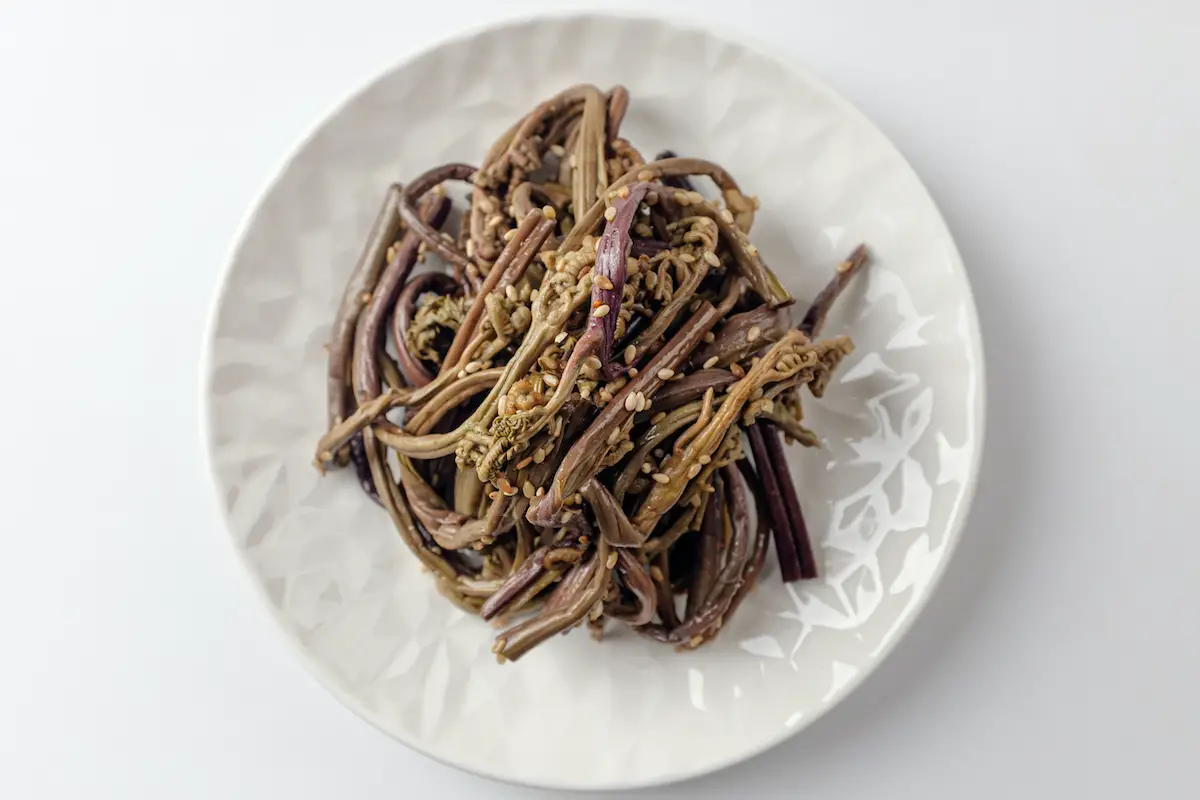This post may contain affiliate links. Please read my disclosure for details at the bottom of this page. As an Amazon Associate, I earn from qualifying purchases on this article about gosari, otherwise known as fernbrake, in Korean cooking. We hope you enjoy learning about gosari.
Have you ever foraged for food in your local area? Every spring, in the countryside of South Korea, people go foraging for the young bracken fiddleheads, also known as fernbrake, to cook with and add to traditional dishes. While this mountain vegetable is common throughout the world, most people use it as an addition to their garden rather than an addition to their dinner table.
Here, we learn about this common Korean ingredient and how it is used in Korean cooking!
What Is Gosari (Fernbrake)?
Also known as bracken, the fernbrake plant belongs to a genus of large ferns in the family of Dennstaedtiaceae. Instead of producing seeds or fruits, these coarse ferns produce edible immature fronds known as fiddleheads. In South Korea, as well as in other East Asian cultures, people have eaten these young bracken fiddlehead greens for centuries. These young fiddleheads are also known as ‘the beef of the mountains’ due to their high protein and fiber content.
Gosari In Korean Cuisine:
In South Korea, people refer to fernbrake as ‘gosari’ (고사리). When cooking with this ingredient, people use it in a variety of ways. During the spring months, people eat it cooked fresh. Then, during the rest of the year, people buy bags of dried fernbrake to rehydrate and cook with.
Fernbrake Recipes:
Below, we list a few well-known dishes that often include this vegetable as an ingredient:
- Bibimbap (비빔밥): Probably the most famous Korean food outside of South Korea, bibimbap can be translated to ‘mixed rice.’ This dish contains different cooked vegetables, protein, and sauces. Fernbrake is often included in bibimbap.
- Yukgaejang (육개장): In South Korea, people add fernbrake to certain types of stew. Most commonly, it is added to this spicy beef stew.
- Gosari-Namul (고사리나물): Also known as stir-fried fernbrake, this Korean side dish is often served throughout the year!

Fernbrake Frequently Asked Questions:
Now that we learned about fernbrake in Korean cuisine, we want to answer some questions you may have about this ingredient! If we do not answer your question, feel free to leave a comment in the section below or email us at [email protected].
What Does Gosari Taste Like?
Gosari has a deep earthy flavor that also takes on other flavors it is cooked with. It is chewy which adds texture to any dish it is added to.
Where Can I Buy Fernbrake?
Unfortunately, you cannot find this ingredient at your local Western grocery in the United States. Instead, shop for this vegetable in your local Asian grocery store or online. As I stated above, you can find fresh fernbrake during the spring. Otherwise, you can find the dried version throughout the rest of the year.
Where to Buy Korean Ingredients Online?
Nowadays, there are many online options to choose from to order Korean food online. These websites are not limited to but include:
- Amazon
- H-mart
- Hanpoom
- Wooltari
How Do I Properly Store This Ingredient?
To store fresh fernbrake, I recommend placing the bunch in the refrigerator and eating it within a few days.
You can place dried fernbrake in a cool, dark place like the pantry and store it for months. You can also store the dried fernbrake in the refrigerator if you prefer!
We Hope You Enjoyed Learning About Fernbrake (Gosari)!
In the end, we hope you enjoyed learning about the fernbrake, otherwise known as gosari in Korean! If so, let us know in the comment section!
If you would like to read more about cooking, you can find recipes as well as further Korean ingredient articles on our blog. We listed some of our favorite Carving A Journey Korean recipes below! For reference, many recipes are influenced by our blended Korean and Southern heritage.
Korean Ingredient Articles:
- Korean Eggplant (Gaji)
- Jujubes in Korean Cooking (Daechu)
- Chrysanthemum Greens in Korean Cooking (Ssukgat)
- Dandelion Greens in Korean Cooking (Mindeulle)
- What Is a Korean Melon? (Chamoe)
- Black Sesame Seeds in Korean Cooking (Heukimja)
Further Carving A Journey Recipes:
- Korean Watercress Salad (Minari Muchim)
- Yakult Soju Cocktail Recipe
- Korean Cabbage Pancakes Recipe (Baechu Jeon)
- Vegetarian Sausage Balls Recipe
- Korean Grits Bowl (Southern-Korean Fusion Dish)
If you have any questions or comments, you can also email us at [email protected].
And, finally, we would love to hear from you through our social media as well! You can follow us at @carvingajourney on Instagram, Facebook, and Pinterest. I also started a vlog Youtube channel! Or, if you would like more articles like these, you can subscribe to our blog by joining our mailing list. Let us know if you try using gosari when cooking! Thank you so much for stopping by!
Carving A Journey is a participant in the Amazon Services LLC Associates Program, an affiliate advertising program designed to provide a means for sites to earn advertising fees by advertising and linking to Amazon.com. Although we may earn commissions for our endorsement, recommendation, testimonial, and/or link to any products or services from this website, these opinions are my own and I fully support these products.

